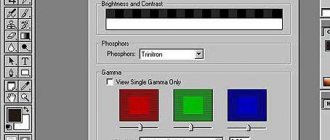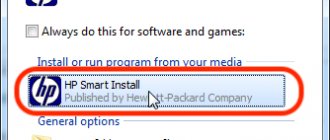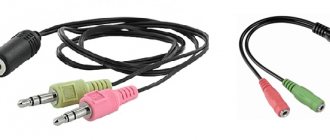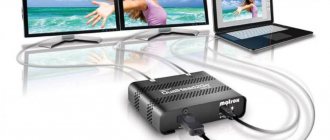Two or more monitors have been connected to one computer or laptop via a motherboard or video card for decades, although the graphical user interface appeared on PCs relatively recently. Today, connecting two monitors to a computer or using a laptop as a second display is a task for a preschooler. The Windows 10 or 7 operating system itself detects and configures screens. You just need to avoid mixing up cables and connectors (HDMI, VGA, DVI) and select the optimal mode for displaying information.
How to make a second monitor on a computer or laptop Windows 7 or 10
Connecting a second monitor to a computer or laptop consists of two stages: “hardware”, associated with the equipment, and “software”, that is, with Windows settings. The hardware stage consists of finding and comparing the availability of free, matching connectors for video transmission on the motherboard of a computer or laptop and in the monitor case. The most popular today are HDMI, VGA, DVI, Display Port, Thunderbolt. Since the connectors are different, quite often a connection via an adapter is required.
To connect 2 monitors to a computer or laptop, you need two connectors.
If you plan to connect two monitors to your computer at once, then you need to think about choosing components in advance. Most modern motherboards and video cards installed in desktop PCs have two or more connectors.
If this is not the case, there are three ways to solve the problem:
- replacing the video card or motherboard with one that has several outputs;
- installing a second video card if there is a free PCI slot on the motherboard;
- using a splitter - a connector splitter.
The last method is the easiest and most budget-friendly, but it can only be used with fast modern interfaces, which include HDMI. Since any branching “takes” part of the bandwidth for itself, connecting two monitors to one weak computer connector will lead to a drop in the permissible resolution and scan frequency. This will be noticeable when watching videos in 4K or even Full HD.
As for connecting a second monitor to a laptop, replacing the video card in them is simply impossible. If you plan to use a laptop or netbook with an external monitor, it is better to immediately choose a model with one or more fast video outputs. Moreover, the overwhelming majority of such models are now - even ultra-thin ultrabooks are equipped with some kind of interface with a wide data transfer channel.
Additional monitors suddenly stop working
If you've been using multiple monitors for a while now and everything has been fine, but suddenly the additional monitors just stop working. Fortunately, this can usually be fixed.
Check your connections:
Make sure that the second monitor is connected correctly and that the cables have not become disconnected since the last time it was turned on.
Remind Windows:
sometimes Windows freezes a little and seems to lose information about additional monitors. Restart your graphics card drivers by pressing the Win + Ctrl + Shift + B keys. Hold them for a second and release. See if this helps bring your second monitor back to life.
Reboot everything:
turn off Windows and all monitors. Then turn everything back on. Often this helps solve the problem.
If necessary, roll back driver updates:
If the screen driver has recently been updated, this may also be causing the problem. Go to Device Manager, select Display Adapters, and select your display adapter to see more. Go to Properties, find the Driver tab and select Roll Back Driver.
Cables for connecting a second monitor to the motherboard of a computer or laptop
To connect a monitor to a computer, they must have compatible input and output connectors, respectively. To connect two monitors, of course, you need a double set of compatible connectors. At the moment, the following video interfaces are more or less widespread:
- VGA is an analog connector that appeared back in 1987. Although this standard is obsolete, it can still be found. If you need to connect an old computer with a VGA output to a modern display or vice versa, adapters are used
- DVI is the most common interface, supports both analog and digital signals (depending on the connector subtype)
- HDMI is an interface for transmitting a high-definition digital signal. Initially used to connect plasma panels, now it is found everywhere, displacing both VGA and DVI
- DisplayPort and mini DisplayPort are different formats of the same interface. Has a number of technological advantages over DVI and HDMI - in particular, the cable bandwidth allows you to connect multiple displays with higher resolution than using HDMI
- Thunderbolt is a logical development of DisplayPort. Has record throughput – up to 10 Gb/s; this allows you to connect up to seven displays simultaneously without loss of quality or additional amplifiers. Fully compatible with mini DisplayPort connector. It is quite poorly distributed due to the fact that it was developed only a few years ago and at first did not have adapters that ensure compatibility with other standards;
- USB, a ubiquitous and invincible interface, is not very well suited for real-time video transmission, and monitors with a built-in USB controller are relatively rare. But such displays completely eliminate the problem of connector compatibility - they can even be connected to a netbook, if, of course, its processor can withstand such a load.
In most cases, it is physically impossible to connect an unsuitable cable, since the plugs have different sizes and number of contacts. If the monitor and computer or laptop do not have compatible connectors, adapters are used. I have already talked in more detail about the hardware connection features in the article about connecting a TV to a computer. If both monitors and the computer have identical connectors, then it is very convenient to connect a special tee-splitter to the computer, and to it - the cables from the two monitors.
Connecting a second monitor to a laptop is also not difficult if it is equipped with an additional HDMI output or some other one through which you can transmit a video image. In this case, you won’t even need any splitters, since it already has one monitor by default.
Another convenient way is to connect the monitor via wifi. This will eliminate the need to lay additional wires.
Distortions and artifacts
Sometimes the second monitor works, but it develops distortions and artifacts that make it difficult to use or impossible to use in games. If your first monitor does not have these display issues, then the problem is likely with your hardware. It can usually be resolved by doing the following:
Check your monitor ports:
Make sure all ports on your computer are clean and free of dust. If there is still dirt, very carefully clean it with weak jets of compressed air and check for damage to the port or cable.
Buy a new cable for your second monitor:
Your cable may be old and faulty. This is especially true if the cable is not shielded and is subject to interference from Wi-Fi, Bluetooth, and nearby electrical interference. Choose a new cable with good shielding.
Shorten the cable length:
choose a new cable shorter than the old one. The longer it takes for data to travel along a cable, the more likely it is for interference to occur, so a shorter cable can reduce artifacts and similar problems.
If you use converters or adapters, try connecting without them: look for cables that don't require separate adapters or switches to control them.
How to connect two monitors to one computer or laptop in Windows?
Most of the software phase is automated. When connected correctly, the computer and the second monitor “find” each other themselves. In most cases, immediately after connecting the cable, the operating system detects the second monitor and switches the image to it. In the most popular versions of Windows 10 and 7, when you connect a display to a laptop, the same picture is displayed on both screens. When you connect a second monitor to a desktop PC, the desktop is “stretched” by default.
However, sometimes the automatic search does not start for some reason - the new monitor continues to light up with the words “No Signal”. The most common reason for this is simply poor contact. Sometimes the problem is in the OS - the computer identifies the new device, but the data display simply does not turn on.
In this case, you need to “hint” at the need for searching. This is done using standard Windows tools through the desktop properties window or the control panel.
Windows 10
In Windows 10, you can manually start detecting a second monitor through the menu “Start - Windows Settings - System - Display”
Here you need to click on the “Detect” button in the “Multiple displays” block
Windows 7
In Windows 7, settings can be reached by following the menu chain “Start > Control Panel > Hardware and Sound > Display > Connect to an external display”
Windows 8
In Windows 8, instead of “Connect to an external display,” there is a “Second Screen” module. If your computer has a discrete video card, for example, from nVidia or AMD, then their proprietary utilities also allow you to configure an additional monitor.
What is your opinion: is WiFi harmful?
Yes
22.91%
No
77.09%
Voted: 36453
Windows XP
In Windows XP, this setting occurs through the “Options” tab of the “Properties” window, which can be opened by right-clicking on an area of the desktop free from shortcuts.
Method No. 2 Reboot the computer
In the Windows operating system (as, indeed, in any other OS), various bugs and errors sometimes arise that prevent it from working correctly, and, as a result, prevent the user from using the functionality of the OS.
Try restarting your machine to fix the possible problem. There is a possibility that the problem is on the side of your OS, which stubbornly does not want to detect the connection of another monitor in available devices. After rebooting, try the method described above again.
Setting up dual monitors on a laptop or computer running Windows 10, 8, 7 and XP
Selecting the dual-monitor display mode on Windows 10 is called by the keyboard shortcut “Win + P”
Let's go through the basic settings of the second monitor. In all versions of Windows, the user of a computer or laptop can independently select the display mode:
- Only on a computer or laptop screen
- On both in “mirror” mode, that is, the second display will exactly copy the contents of the first
- On both, in the desktop stretch mode, the screen space will seem to be divided into two parts
- Only on the second connected monitor
Screen resolution
Setting the screen resolution is useful if you are using two monitors of different formats. The resolution of the worst of them should be used. Otherwise, part of the picture will go beyond the display with smaller dimensions.
Another parameter that is used relatively rarely is the choice of image orientation, landscape or portrait. It is more relevant for working with the mobile version of Windows on a tablet. Windows 8 has two additional orientations - inverted landscape and portrait. They are needed for comfortable work with displays that rotate freely around all three axes.
Settings
After connecting an external monitor and turning on the PC, nothing will happen. A message often pops up on the screen saying there is no signal and there is no image. It happens even “better” - the monitor is simply not detected by the computer.
Let's go to graphic settings. Call up Windows settings (Win+I), the “System” section and the “Display” tab. The system itself writes that older models may not be detected automatically. Click on “Detect” so that Windows finds the one you need.
The second monitor should be displayed graphically - under the number 2. The active display is always highlighted in blue. The brightness, resolution, orientation, and other parameters are relevant for the selected screen.
Multiple display settings are important. You can set four parameters:
- duplication: two screens will have the same picture;
- expand: the contents of the first monitor will expand as a continuation to the second;
- show on 1 or 2: depending on the selected monitor, the picture will be shown on only one of them - the main or additional, external one.
How to connect several non-overlapping monitors to one computer?
In corporate networks, it is not uncommon for many employees to work on the computing power of one server. At the same time, of course, they have their own desktops that do not intersect in any way. Is it possible to implement such work on a home scale?
By and large, no. With only utilities, a splitter and an OS, it will not be possible to organize a multi-screen working system. Because it requires several independent video streams, and this is not possible with every graphics card.
True, if two video cards are hidden under the case at once, it is still possible to arrange independent desktops on separate monitors. It is enough to connect displays to the connectors of different boards and configure the drivers for multi-screen mode. Powerful discrete video cards that have more than one of their own computing cores also allow two screens to work independently of each other - this mode is configured through the manufacturers' utilities.
However, recently a special device has appeared on the market with which you can organize a more interesting configuration of screens and desktops - Matrox DualHead2Go.
The Matrox company claims that with this adapter, owners of home computers and laptops will be able to connect two displays to the simplest video card they already have with an analog output. If we are talking about a laptop, then it will be possible to attach two displays to it at once, and the main screen of the laptop will show one desktop, and 2 monitors will show another). All that is required is that your video card is modern enough and compatible with DualHead2Go.
The operation of this adapter is simple - it splits the video signal into 2, and a special application, which comes with it on a disk and is installed on the laptop, ensures that the picture is distributed correctly in accordance with the specified settings.
Intel Graphics Panel Settings
Graphics card manufacturers often offer support software for customizing screen settings. You can work with two monitors in the Intel Graphics Panel. It usually starts automatically. Let's go into it through the icon on the taskbar.
In the “Display” section, select the category we need – “Multiple displays”. If there is a second monitor connected, the possible settings for the two screens will be displayed here.
Technical characteristics are set in the basic settings section. You need to choose a built-in (if laptop) or external display.
Why do you need to connect two monitors to your computer or laptop?
Practical applications of connecting two monitors and using dual-screen computer systems are endless.
Increased work space
The first and obvious one is to improve user efficiency. A desktop stretched across two displays allows you to keep twice as many windows open at the same time. This is useful for many office workers. And for representatives of creative professions - artists, video editors, composers who write music in virtual synthesizers - it is absolutely necessary. Engineering drawings can be viewed in greater detail and on a larger scale, which is valuable when you need to study the future mechanism as a whole. The execution of many tasks related to processing statistics is significantly accelerated - you do not need to switch applications ten times to compare data from three tables and five graphs. All of them can easily fit into a double “working area”.
The effect of presence in games
The second most obvious - and, perhaps, the first most popular way to connect two monitors on one computer - is games. Multiplayer shooters feel completely different when two characters are in the same location at the same time. And we don’t even have to talk about how much better 3D graphics look on a wide “plasma” than on a small laptop screen.
Simultaneous work in two programs
At least two displays are used by professional programmers. The code and the result of its execution; a documentation file and a disassembled section causing a crash - painstaking work can be annoying and tiring if you need to constantly “blink” windows.
Training and presentations
In production and training, it is much easier to install a second monitor that mirrors the main one than to have two people in front of one screen. A visitor at the bank and a schoolchild, to whom the teacher shows the necessary paragraphs from an electronic textbook, can sit comfortably on their side of the table if there are two monitors connected to one computer.
Load distribution
And finally, organizing multi-user work across an office or home is a logical solution if you have a sufficiently powerful PC with a modern multiprocessor graphics system. Two displays using different video streams will forever end the debate “who needs a computer more now?”
Some restrictions
There are situations when the user connects an additional monitor, but there is no positive result from this action: the picture is not output to the external device. The scenario where the laptop does not see the monitor happens on older models. They simply do not provide for dual-screen operation.
Advice! The first thing you need to do is look at the laptop's specifications on the manufacturer's website. There is information not only about whether the system works with two displays. From the documentation you can learn how to switch your laptop screen to a monitor or make other useful settings.
There is also an option when you don’t have to study the instructions for the model. Especially if there is no version in Russian. Just take a close look at the keyboard. The button that is responsible for switching display devices usually has an icon in the form of a recognizable pictogram. Therefore, if the laptop does not display the image on an external monitor, you need to press Fn + the found key.
Some mobile computer models simply cannot support two display devices. If you want to connect a second monitor to your laptop, you will have to switch the active card in the BIOS. How to enter it should be found in the documentation for the model. After logging in, you need to:
- go to the Advanced section;
- find the Init Display First option;
- set its value in PCI.
Important! This method has some inconvenience. While the external monitor is running, there is no image on the laptop display. To return it, you need to change the option value in the BIOS settings to Int.
Warnings
- If your monitor resolutions are different, reduce the high resolution to make it equal to the lower resolution. If you do not do this, graphic errors will occur.
Sources
- https://InstComputer.ru/sovety-nachinayushhim/kak-podklyuchit-monitor-k-noutbuku.html
- https://www.ibik.ru/ru/connect-two-monitors-one-computer/
- https://reedr.ru/elektronika/noutbuk/kak-podklyuchit-dva-monitora-k-noutbuku/
- https://www.Moyo.ua/news/kak-podsoedinit-2-monitora-k-pk-nastroyka-i-soft-dlya-raboty-s-dvumya-monitorami.html
- https://prostocomp.net/sistema/kak-podklyuchit-monitor-k-noutbuku.html
- https://tehnika.expert/cifrovaya/noutbuk/podklyuchenie-monitora.html
- https://ru.wikihow.com/%D0%BD%D0%B0%D1%81%D1%82%D1%80%D0%BE%D0%B8%D1%82%D1%8C-%D1% 80%D0%B5%D0%B6%D0%B8%D0%BC-%D0%B8%D1%81%D0%BF%D0%BE%D0%BB%D1%8C%D0%B7%D0%BE %D0%B2%D0%B0%D0%BD%D0%B8%D1%8F-%D0%B4%D0%B2%D1%83%D1%85-%D0%BC%D0%BE%D0%BD %D0%B8%D1%82%D0%BE%D1%80%D0%BE%D0%B2
Port Usage
Modern laptops always have a group of ports designed to connect monitors or TVs to them. Their set may vary depending on the manufacturer and year of manufacture of the mobile device model.
- Classic analog. Most monitors are connected via VGA.
- Analog-to-digital. Via HDMI, you can output not only the image, but also the sound to a TV or monitor with speakers.
- Digital DisplayPort. It can be used to connect more than just one monitor. Some cards, in particular ATI Radeon, thanks to proprietary technology, allow you to connect 3 monitors or TVs (up to 6 devices in total).
However, the problem often arises for those who have an old monitor that does not have a suitable port for connection, and a modern laptop. To fix this problem you will need a special adapter. For example, HDMI-VGA. It is not difficult to buy such a device, but you should choose solutions from well-known manufacturers.
Important! It is worth remembering that when the laptop is running, an external device is never connected. To do this, you need to turn off your computer.











